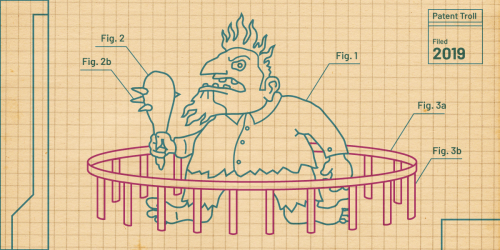The White House updated the nation on its commitment to curtail the patent troll problem and tie up some egregious loose ends in our patent system, announcing progress made on all fronts—as well as three new executive actions. While the Innovation Act (and other patent bills) is pending in the Senate, it is encouraging to see the White House and Patent Office taking steps on their own to address these rampant problems.
One of the most useful announcements is a toolkit put out by the Patent Office called Been Sued or Gotten a Demand Letter? that highlights a variety of best practices and resources for businesses and individuals who are facing a troll threat. (In fact, one of the resources the PTO suggests is our Trolling Effects project.) One of the biggest questions we get from companies who have received a demand letter is, "What do we do now?" It's important that the Patent Office provides such resources to empower businesses and curb abusive litigation practices.
The Patent Office is also addressing one of the biggest problems behind broad, vague patents (especially software patents): functional claiming. This is the practice of patenting what something does, rather than what it is. In order to help limit this practice, the PTO put together a training program for patent examiners and judges, so they can understand these sorts of claims better. We think this program is a promising first step, but the PTO needs to do more to limit the use of broad functional language in patent claims. Another common issue is the use of vague terms in patent claims that mean several different things across the board ("transmission," "server," etc.). We suggested the PTO use glossaries to implement some sense of consistency (PDF), and they announced today they are piloting such a program.
The rest of the updates are important as well, such as a new rule proposal (PDF) for making patent ownership more transparent, and an increased number of empirical studies about the state of the patent system.
We also applaud the three new executive actions:
- Crowdsourcing prior art: Right now, it is very difficult to find prior art—previous inventions and published ideas that cover a claim—especially for vaguely worded software patents. The Patent Office is tasked to widen its use of third-party prior art tools, such as Ask Patents.
- More training: Building upon its current training revisions, the Patent Office will put more effort into training its examiners in technical capacities.
- Pro bono and pro se assistance: Not everyone can afford a lawyer, especially small businesses and inventors. The Patent Office is putting together resources to educate those who wish to represent themselves ("pro se"), and those who seek free ("pro bono") counsel.
These announcements are important steps toward patent reform—and these changes are happening now. While we wait for legislation to pass and codify needed reform, it is encouraging to see the White House do what it can within the scope of its power to fix the patent system.
Ultimately, though, legislation is needed. During the State of the Union address in January, President Obama said to Congress, "Let's pass a patent reform bill that allows our businesses to stay focused on innovation, not costly and needless litigation." The Innovation Act is the best reform bill yet, and we're pushing for the Senate to not only take up the legislation, but to strengthen it with important patent quality provisions.
We welcome the White House's and the Patent Office's commitment to combat patent trolls and fix the system. Now let's get a strong bill through Congress to set important reforms in stone.







